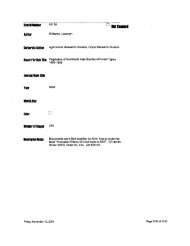Epidemiologic Investigation of Health Effects in Air Force Personnel ...
Epidemiologic Investigation of Health Effects in Air Force Personnel ...
Epidemiologic Investigation of Health Effects in Air Force Personnel ...
You also want an ePaper? Increase the reach of your titles
YUMPU automatically turns print PDFs into web optimized ePapers that Google loves.
The <strong>in</strong>herent match for SEA experience controls for combat-<strong>in</strong>duced physiologic,<br />
psychophysiologic, and other related morbidity and mortality disorders.<br />
Additionally, this <strong>in</strong>herent match may reflect the effects <strong>of</strong> alcohol consumption,<br />
the use <strong>of</strong> chemoprophylactic and/or illicit drugs, and the acquisition<br />
<strong>of</strong> tropical diseases associated with life <strong>in</strong> SEA. The comparisons <strong>of</strong> the<br />
exposed (RANCH HAND) subjects and their selected sets <strong>of</strong> controls are detailed<br />
<strong>in</strong> Appendix Table A-4. Only 4 <strong>of</strong> the ten categorical AFSC/case strata had<br />
less than ten controls for each exposed subject. The group <strong>of</strong> Caucasian<br />
pilots had a mean <strong>of</strong> only 9.5 controls per exposed subject, due to the extreme<br />
ages <strong>of</strong> several <strong>in</strong>dividuals, and the strata <strong>of</strong> Black pilots and other Black<br />
<strong>of</strong>ficers had means <strong>of</strong> 2.7 and 5.0 controls respectively. However, s<strong>in</strong>ce there<br />
were only seven black <strong>of</strong>ficers <strong>in</strong> the exposed group and only thirty controls,<br />
high numbers <strong>of</strong> tight rnatchos could not be achieved. Black enlisted aircrewmembers<br />
had a mean <strong>of</strong> 9.8 controls each.<br />
(4) Computer Science and Statistical Petal 1s <strong>of</strong> the Match<strong>in</strong>g Process<br />
As described above, the match<strong>in</strong>g for this project has been performed us<strong>in</strong>g<br />
three variables: occupational category, race and age. Five occupational<br />
categories (<strong>of</strong>ficer/pilot, <strong>of</strong>ficer/navigator, <strong>of</strong>ficer/other, enlisted/flight<br />
eng<strong>in</strong>eer, and enlisted/other) have been used to reflect socioeconomic status<br />
and aeronautical rat<strong>in</strong>g. The variable <strong>of</strong> race has been dichotomized <strong>in</strong>to<br />
black and non-black. Ten matched controls have been selected for each exposed<br />
subject, regardless <strong>of</strong> current vital status. The computer method applied to<br />
select the control subjects is an adaptation <strong>of</strong> a procedure studied by Raynor<br />
and Kupper (Nearest Neighbor Match<strong>in</strong>g on a Cont<strong>in</strong>uous Variable, Technical<br />
Report, Department <strong>of</strong> Biostatistics, University <strong>of</strong> North Carol<strong>in</strong>a, 1979). As<br />
the first step, the RANu! HAND and control groups were partitioned <strong>in</strong>to ten<br />
strata us<strong>in</strong>g the categorical occupational and race variables. The Raynor and<br />
Kupper match<strong>in</strong>g procedure was then applied iteratively with<strong>in</strong> each <strong>of</strong> the<br />
strata to match for the cont<strong>in</strong>uous variable <strong>of</strong> age, given <strong>in</strong> months. The<br />
Raynor-Kupper procedure <strong>in</strong>volves the follow<strong>in</strong>g steps:<br />
STEP #1.<br />
STEP #2.<br />
match<strong>in</strong>g.<br />
The RANCH HAND cohort <strong>in</strong> a given strata is randomly permuted.<br />
The first RANCH HAND subject <strong>in</strong> the permuted set is selected for<br />
STEP #3. The closest available control is assigned to the selected RANCH<br />
HAND subject us<strong>in</strong>g the absolute value <strong>of</strong> the difference between the months <strong>of</strong><br />
birth <strong>of</strong> the RANCH HAND and the control subjects. If the closest available<br />
control is further than 60 months from the selected RANCH HAND subject, a<br />
blank is assigned. Tied assignments are broken randomly.<br />
STEP #4. Step #3 is repeated for all RANCH HAND subjects <strong>in</strong> the strata<br />
proceed<strong>in</strong>g down through the permuted set, until the entire RANCH HAND cohort<br />
is exhausted.<br />
STEP #5. Steps #1 through #4 are repeated ten times for each RANCH HAND<br />
subject to construct a 1:10 study set. At the completion <strong>of</strong> the match<strong>in</strong>g<br />
activity, the RANCH HAND - Control study matrices for each <strong>of</strong> the ten occupation-race<br />
strata can be diagrammatically represented as <strong>in</strong> Figure #1.<br />
24
















